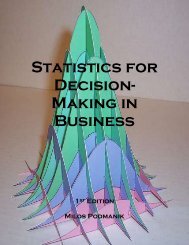Tutor Training Manual.indd - Chandler-Gilbert Community College
Tutor Training Manual.indd - Chandler-Gilbert Community College
Tutor Training Manual.indd - Chandler-Gilbert Community College
Create successful ePaper yourself
Turn your PDF publications into a flip-book with our unique Google optimized e-Paper software.
16<br />
Learning Styles<br />
Introduction<br />
The different approaches people use to learn or study are called learning styles. Each of<br />
us has a unique preference for how, when, where and with whom we’d like to learn or<br />
study, and these preferences help to enhance our learning potential. Learning styles do not<br />
reflect a person’s academic ability or achievements. Rather, the styles are a combination<br />
of environmental, emotional, sociological, physical and psychological factors that influence<br />
how a person receives, processes and stores new information. Often times a person has<br />
more than one learning style or preference. Therefore, it is good practice to present<br />
information in a variety of ways to help encourage the student to be successful regardless of<br />
how information is presented. As a tutor, you must be sensitive to the signals that indicate<br />
a student’s learning style.<br />
Major Learning Styles<br />
There are four main learning styles, Visual Learners, Auditory Learners, Read/Write<br />
Learners and Tactile Learners, and their characteristics are given below. <strong>Tutor</strong>ing<br />
strategies are also provided to help you capitalize on the strengths of each style.<br />
Learning Style<br />
Signals<br />
·<br />
·<br />
·<br />
·<br />
·<br />
·<br />
Visual Auditory Read/Write Tactile<br />
If I see it, I know it! If I hear it, I know it! If I read it, I know it! If I do it, I know it!<br />
Prefers to get<br />
information by seeing<br />
Likes looking at books,<br />
pictures, puzzles, etc.<br />
Strong sense of color<br />
Difficulty with spoken<br />
instruction<br />
Trouble following<br />
lectures<br />
Misinterpretation of<br />
words<br />
·<br />
·<br />
·<br />
·<br />
·<br />
Prefers to get information<br />
by listening<br />
Likes to tell jokes and<br />
stories<br />
Remembers spoken<br />
words, ideas, lyrics to<br />
music<br />
Difficulty following<br />
written instruction<br />
Problems with writing<br />
·<br />
·<br />
·<br />
·<br />
·<br />
Prefers to get information<br />
from text<br />
Likes reading and writing in<br />
all forms<br />
Likes lists, textbooks,<br />
handouts, etc.<br />
Emphasis placed on words<br />
and the meanings of words<br />
Difficulty with spoken<br />
instruction<br />
·<br />
·<br />
·<br />
·<br />
·<br />
Prefers to get<br />
information by touching<br />
Likes to work with<br />
hands<br />
Learns better when<br />
physical activity is<br />
involved<br />
Difficulty sitting still<br />
Not avid readers<br />
Learning Tips<br />
·<br />
·<br />
·<br />
Graphics reinforce<br />
learning<br />
Color coding to organize<br />
notes<br />
Written instructions<br />
·<br />
·<br />
·<br />
Study by talking the<br />
information through with<br />
someone<br />
Learn by participating in<br />
discussions<br />
Recite out loud anything<br />
that needs to be<br />
remembered<br />
·<br />
·<br />
·<br />
Write out words again and<br />
again<br />
Read notes (silently) over<br />
and over again<br />
Summarize flowcharts or<br />
diagrams with words<br />
·<br />
·<br />
·<br />
·<br />
Follow your finger as<br />
you read<br />
Take frequent breaks<br />
while studying<br />
Pace or walk while<br />
reciting information on<br />
index cards<br />
Tracing letters and<br />
words to remember<br />
facts<br />
<strong>Tutor</strong>ing Tips<br />
·<br />
·<br />
Give visual directions<br />
and clues<br />
Use flashcards, maps,<br />
graphs, color coding and<br />
other visuals to increase<br />
understanding<br />
·<br />
·<br />
·<br />
·<br />
Allow the student to<br />
verbalize whenever<br />
possible<br />
Talk through steps in<br />
tasks<br />
Reinforce all visual<br />
directions with verbal<br />
clues<br />
Allow a lot of wait time for<br />
questions<br />
· Utilize handouts<br />
· List steps used to arrive at<br />
the conclusion<br />
·<br />
·<br />
·<br />
·<br />
Use movement to help<br />
reinforce the concept<br />
Use manipulative<br />
learning aids<br />
Use role playing<br />
Use the computer to<br />
write drafts, etc.<br />
Adapted from http://www.ccsf.edu/Services/LAC/lern10/newlearnsty.html<br />
Adapted from http://www.vark-learn.com/english/index.asp

















